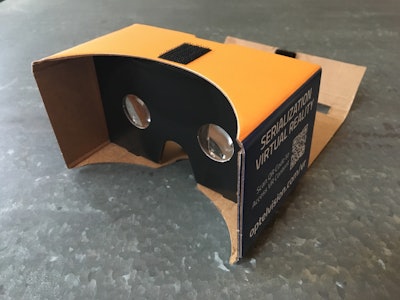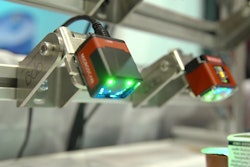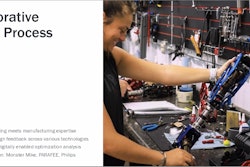
Attendees of the recent PACK EXPO International and Pharma EXPO 2016 events know there’s no shortage of solutions to addressing serialization. Nearly half of the presentations on the show’s Innovation Stage directly referenced serialization. In their booth at Pack Expo International, Optel Vision offered a virtual reality experience to familiarize potential clients with their serialization product suite.
You could use Oculus to tour their booth, but I was also presented a branded paperboard packet as a takeaway that when opened and assembled, via basic origami techniques, yielded a 3-D virtual reality reader. The device was nearly identical to Google’s famous low-tech reader appropriately dubbed “Cardboard.” The dichotomy of archaic binocular technology enabling a cutting-edge interactive experience was ironic yet intriguing. My prior experience with virtual reality, a singular event nearly two decades ago, consisted of 8-bit dinosaurs chasing me through a prehistoric landscape in a “game” called “Pterodactyl Nightmare.” So with a deep breath, I scanned the QR Code, placed my phone in the viewer, and peered inside.
As I lifted the viewer to my face, my office was transformed into the type of high tech lab that might harbor a Bond villain deep within a dormant volcano. A quick 360 revealed the Optel Vision serialization suite conveniently laid out around me. Centered in my field of vision was a small cursor that when hovered over machine parts enabled popups highlighting product features. For example, focus on the PackStation’s monitor and a popup appears to inform you this machine inspects and verifies parent labels while recording serialization data. A far cry from the adrenaline rush I’d experienced dodging raptors as a 10-year-old, but quite possibly the most interesting content I’d encountered on the topic of serialization.
I spent roughly 20 minutes exploring the virtual demonstration, which to an onlooker could’ve been mistaken as a goggled mime attempting to escape an invisible box. By the end I was not only familiar with Optel Vision’s serialization solutions, I was also slightly dizzy. Read on to learn more about the suite of products, or click here to go straight to the source.
BottleTracker™ is Optel Vision’s tracking code association station for bottles. It features four small cameras that can read a Data Matrix, whether visible or UV ink, from any angle. The information is displayed on a human machine interface (HMI) that an operator can monitor, and creates reports that are fed directly to Optel Vision’s LineMaster. A narrow belt moves bottles though the machine keeping the Data Matrix visible for 360° inspection. Rejected bottles are removed from the line and placed in a separate compartment with its own verification sensor. The machine can process 300 bottles/min and accommodate bottles 35-114.5mm.
PalletMaster™ is a serialization manager for the centralized palletizing room. It allows identification and verification of both cases and pallets with cameras and/or barcode scanners. The system is designed to retrofit with existing robot systems that palletize different lots on different pallets simultaneously. PalletMaster can employ cameras and print-and-apply coders to be automatic or manually scanned by operators.
BundleTracker™ is an automated aggregation product that establishes a parent/child relationship between bottles and bundles to verify products and check for proper counts. A built-in camera inspects bottom tracking codes and reads the data matrixes of visible and UV ink. As bundles move through the machine, labels are printed and applied from above and immediately inspected. Rejected bundles are removed from the line and placed in a separate receptacle with its own verification sensor. It features a user-friendly interface for reporting and is capable of processing 100 products/min.
PackStation™ aggregates individual bottles or cartons in single or multi-layered cases and can handle a variety of product sizes. It is available with varying levels of automation including fully manual, semi-automated and completely automated. The virtual tour highlighted the semi-automated option, which combines automated operations with manual packing provided by an operator. Products are fed via conveyor belt into the packing station where they are manually loaded into boxes. Once loaded, an overhead camera snaps a picture of the case and generates a label that is automatically applied to the box. That label is scanned and verified before the operator loads it onto the pallet, and then a final pallet label is generated and printed.
As we inch toward the serialization deadline, innovative product offerings will continue to emerge and saturate the market. Companies that are able to apply a unique customer experience to sales and back it up with quality products are sure to make an impression. The unique use of virtual reality to sell a product was a welcomed change of pace; I wouldn’t be surprised to see the paradigm shift toward corporate application in lieu of Jurassic terror.






















